Hyundai Motor has mastered the technology of sensing the inside and outside of the car → analyzing the planned driving route → automatically controlling driving, and gradually obtained the ability to intelligently assist human driving. As technology matures, Advanced Driver Assistance Systems (ADAS) gradually transition to autonomous driving.
From the laboratory to the test site to the production car to the formation of stimulus consumption, in addition to excellent products directly facing the market, policies and regulations are also leading the evolution of complex technology. China Intelligent Network's overall planning, industrial development strategy, technology development route, and standard system planning are being reviewed. Cheyun.com has produced this report. On the one hand, it has systematically sorted out the policies, regulations, and technical routes already published at home and abroad. At the same time, I hope to provide a global perspective for China's policy formulation.
L0-L1 ADAS began to be deployed in production cars, but consumers did not pay for it
The automatic driving grading of NHTSA (National Highway Traffic Safety Administration) and SAE (American Society of Automotive Engineers) has been widely recognized as a reference for understanding the current state of ADAS transition to autonomous driving.
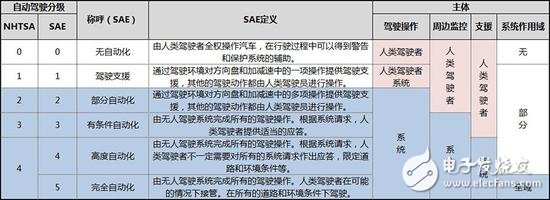
L0 refers to early warning and a small number of protection auxiliary functions, including night vision (NV, Night Vision), pedestrian detection (PD, Pedestrian DetecTIon), traffic sign recognition (TSR), lane departure warning (LDW, Lane) Departure Warning), Blind Spot Monitoring (BSM), and early warning functions such as Rear-Cross Traffic Alert (CTA). The system only gives the driver a warning that the person's hand (steering) and foot (brake) still control the vehicle.
The L1 stage vehicle began to intervene in braking and steering one of the controls, sharing the driver's work, mainly including adaptive cruise (ACC, AdapTIve Cruise Control), lane keeping function (LKA, Lane Keep Assist) emergency brake (AEB, AutomaTIc Emergency Braking) and other functions.
The L2 stage vehicle begins to take over multiple controls in both the vertical and horizontal directions, and the driver's attention remains to maintain driving status so that the vehicle can be taken over at any time. The difference with L1 is that the horizontal and vertical systems need to be fused.
L2 will take over all driving operations by the system. There are special situations in the L3 and L4 phases. Humans need no support. The difference between the two is whether the driving environment is simple or not, and the speed is fast or slow.
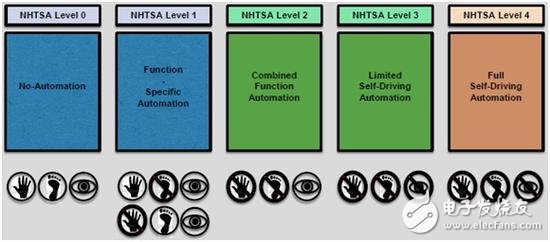
Driver involvement and participation at different levels in the NHTSA automatic driving grading
Advance from L2 to L3 is a leap from ADAS to autonomous driving. Autopilot has been able to fully entrust driving tasks to the vehicle, and even in some critical situations, it can achieve the least safe and secure solution, while ADAS still has human driving operations and attention.
At present, the BBA brand basically popularizes adaptive cruise control (ACC), lane departure warning system (LDW), parallel assist system (ie blind spot monitoring, BSD), forward collision warning system or active braking system (AEB) functions, including Volvo. Tesla has been equipped with AEB function. Most of the high-end versions of GM, Ford, Toyota and other brands are equipped with AEB and ACC functions.
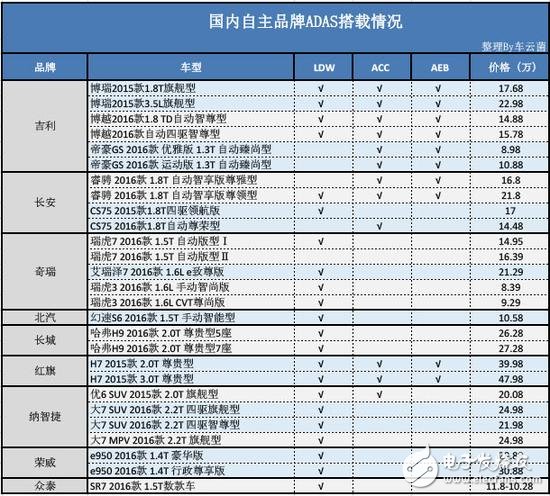
According to the data summary, domestic brands of high-end models began to carry ADAS functions, including night vision (NV), blind spot detection (BSD), lane departure warning (LDW) and other L0 active safety technologies are maturing, began to explore to 100,000 and 10 Under the 10,000-class model, the adaptive cruise control (ACC), the forward collision warning system or the active brake system (AEB) are still exclusive to the high-end vehicle, and the loading rate is not high.
The main challenge of the development of ADAS at this stage is to make more L0-L1 functions enter the price of 100,000 yuan and the following brands. According to industry insiders, the purchase of a single AEB function for a 100,000-selling model requires approximately thousands of dollars in procurement costs. The material cost of a typical vehicle is 60%-65% of the price of the car, and the cost of the car is about 60,000 to 65,000. If you want to balance functions and prices, you need to do the amount on the one hand, and increase the brand premium on the other hand, and amortize the cost to reduce the pressure.
The extra cost of ADAS functionality has, to some extent, led to market feedback. In 2015, McKinsey conducted a survey on connected cars for 5,500 car buyers. More than 70% of users said that they “know what driving assistance functions the ADAS system can provideâ€, and less than 30% of the owners have tried it. Among them, about half of the users who ultimately choose to buy. The well-known American consulting company HIS reported in 2016 that the car network survey for 4,000 people also pointed out that for the automotive ADAS function, consumers have high interest and low willingness to pay. It can be seen that there are still a handful of users who are really willing to take the initiative to pay for the ADAS function.
New car evaluation rules change to promote the popularization of ADASThe popularity of ADAS requires the OEM and component suppliers to reverse the market and rely more on the government's policy support.
The China New Car Evaluation Regulations (C-NCAP), led by the China Automotive Technology and Research Center, is putting active safety into the evaluation system. Prior to this, rating agencies such as the European New Car Safety Assessment Association (E-NCAP) and the National Highway Traffic Safety Administration (NHTSA) have incorporated more ADAS functions into the scoring system.
Scoring rules on active safety after the introduction of new rules in 2013According to the road book published by E-NCAP, since 2013, the adjustment of the scoring rules has increased the content of more ADAS. In 2017, the speed assistance system (SAS), automatic emergency braking (AEB), lane departure warning/lane deviation assistance (LDW/LKD) bonus points have been set to 100% system installed capacity.
On March 18, 2016, NHTSA and the Highway Safety Insurance Association (IIHS) also announced that 20 automakers (GM, Ford, Fiat Chrysler, Toyota, Honda, Nissan, Mazda, etc.), which account for more than 99% of the US auto market share. Mitsubishi, Fuji Heavy Industries, Hyundai, Kia, Audi, BMW, Daimler, Volkswagen, Porsche, Volvo, Maserati, Jaguar Land Rover, Tesla) have agreed to make Automatic Emergency Brake (AEB) become available on September 1, 2022. Technical standards, Toyota said in 2017 to start selling AEBs for new cars in the United States.
Regulations in the domestic market generally follow the European and American markets. According to official data, in the C-NCAP scoring system, the active and secure scoring weights accounted for 15%, and the AEB rear-end and pedestrian (only daytime) scoring items were added.
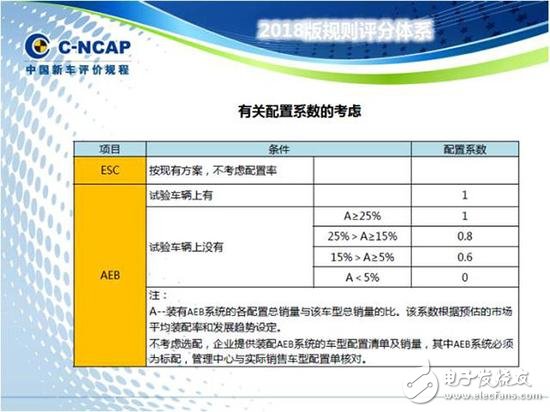
There are some adjustments to the standard setting based on China's current market conditions. Because some models of the original brand are not standard EABs, they are adopted.
Test score × configuration coefficient". Also consider that some manufacturers AEB sensors (currently mainstream sensors are monocular or binocular cameras) are not sensitive at night when the visibility range is poor, so on the AEB pedestrian collision brake Regardless of the nighttime situation, the introduction of the latest C-NCAP evaluation system may stimulate domestic OEMs to popularize L1 and even L2 configurations for product matrices.
China's intelligent network car standard has formed a framework"Made in China 2025" listed intelligent networked cars as one of the key development directions. It is clear that by 2020, we will master the overall technology and key technologies of intelligent assisted driving, and initially establish an independent research and development system and production supporting system for intelligent networked vehicles. In 2025, we mastered the overall technology of autopilot and various key technologies, established a relatively complete independent research and development system, production supporting system and industrial cluster of intelligent networked vehicles, and basically completed the transformation and upgrading of the automobile industry.
The National Automobile Standardization Technical Committee (SAC/TC 114, hereinafter referred to as the Steam Standards Committee) undertook the research and construction of the China Intelligent Networking Automotive Standard System. At present, the intelligent networked automobile standard system program has formed a standard framework system after many rounds of discussions in the industry, and began to solicit opinions. After revision and improvement, it will be publicly released.
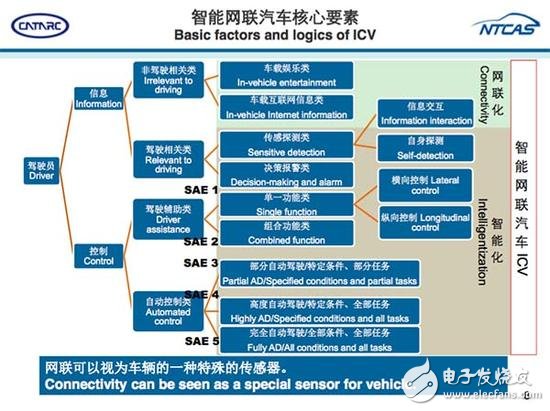
The standard considers the two paths of intelligence and networking, which will be based on intelligence. In the intelligentization, according to the SAE standard classification, the standardization is based on the ADAS technology and application, and the automatic driving is moderately considered.
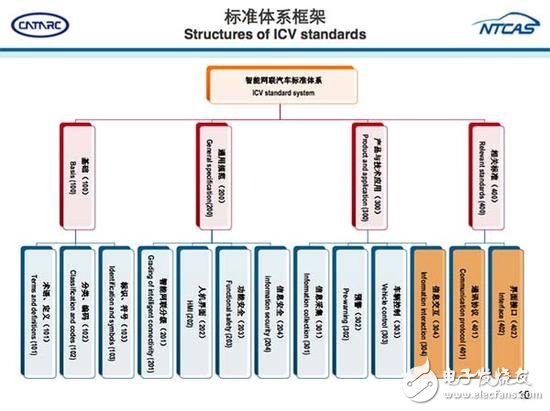
It is reported that the standard system will be divided into four aspects:
1, foundation;
2, general specifications;
3, product and technology applications, including information collection, decision-making alarms, vehicle control.
4, information exchange, communication protocol, connection port.
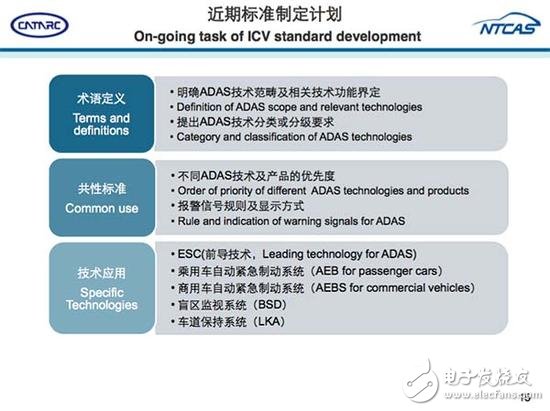
In view of the unclear definition of domestic concepts and the lack of standards, the standardization of the standards of the VTC will begin with the definition of terms, and the common standards and technical applications will be formulated on the basis of defining the classification of ADAS technology and related technical functions, classification and grading.
At that time, ADAS and autonomous driving technology promotion and standard regulations will be divided into two categories, including: automotive and related industry laws, regulations, regulations; mandatory national standards for the automotive industry, and subdivided into recommended national standards for government management. Recommended standards cited by mandatory national standards. At the same time, for the part of the original regulations that restrict the development of smart cars, such as GB17675 and GB11557, the part that requires the driver to directly operate the steering mechanism is adjusted and changed.
National organization issued "ADAS-automatic driving" support policyIn early 2016, in line with the development of autonomous driving technology, the United Nations “World Vehicle Regulations Coordination Forum (WP29)†was responsible for the adjustment and revision of a series of international road traffic safety regulations including the Vienna Convention, and the development of automotive-related The universal standard of the world.

At present, there are contents in the UN Economic Commission and EU rules that explicitly prohibit certain autopilot functions. For example, the 13-H rule requires that the brakes be braked by manual braking or by an electric module controlled by the driver. The 79 rules prohibit the use of electric steering systems, which negates the auto-steering car. The rules also prohibit the use of automatic control systems at speeds in excess of 10 km per hour. The United Nations is organizing changes to these regulations.
The Vienna Convention on Road Traffic, adopted in 1968, states that “the driver must have control over the vehicle at all timesâ€. To some extent, this regulation limits the development of autonomous driving. An amendment that came into effect in March 2016 revised the 68-year version, stating that as long as the autonomous driving technology has the characteristics of “can be covered or taken over by the driver's authority†and this clause is consistent with international laws and regulations, it can Clearly applied to transportation.
The United Nations has developed this standard to prevent autonomous vehicles from being attacked and controlled by hackers. The regulatory standards will include principles, such as limiting autopilot access to highways and human drivers must be responsible for all accidents; including safety regulations, one of which automatically Driving a car must be equipped with equipment that prevents the driver from falling asleep or looking away. This device can use the sensor to determine the driver's status.
In the safety standards for automatic driving, the WP29 sets five technical categories, including vehicles that must travel at speeds below 10 km/h. Lane maintenance must be achieved, driver-initiated lane changes and lane keeping are coordinated, and driving Certified lane change and lane keeping related research. At the same time, it also added relevant regulations of the warning system, conducted research on how the system was taken over, system operation and specific control, and also gave relevant regulations for regular technical inspection.
It is expected to pass the standard in November 2016 or enter into force in 2018. Japan and major European countries dominated the standard setting, and a United Nations expert group composed of representatives from Japan, South Korea, Germany, France, the United Kingdom, the European Commission and the EU executives participated in the standard setting.
United StatesIn 2014, the US Department of Transportation and the United States Intelligent Transportation Systems (ITS) joint project office jointly proposed the ITS strategic plan 2015-2019, which clearly defined the direction of the United States in the field of intelligent transportation in the next five years.
The strategic plan is divided into two parts: the networked car and the automatic driving. The automation project for autonomous driving states that the main research will determine the core elements and performance indicators (research) of automation; test automation components (development) in test sites or other test conditions; the government is promoting and encouraging automation system applications. Winning plays an important role (application).
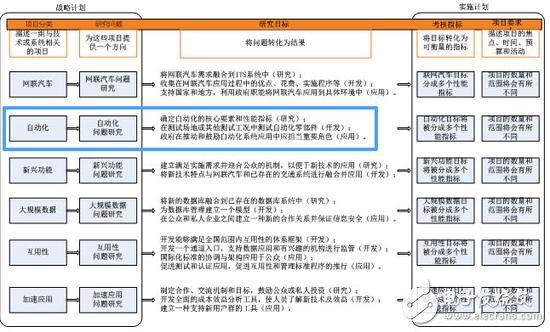
On January 14, 2016, the US government announced
In the next decade, $4 billion will be invested to support autonomous driving, which will be spent from the US government budget for 2017. At the same time, the National Highway Traffic Safety Administration (NHTSA), which is part of the US Department of Transportation, announced that it would waive 2,500 vehicles across the industry for two years to comply with current traffic safety regulations, allowing them to test on the road without a driver.
Although there is no uniform autonomous vehicle test standard in the United States, each state has state regulations. When automakers send autopilot vehicles to road tests, they need to comply with the relevant regulations of the US Federal Motor Vehicle Safety Standards (FMVSS) and go through various procedures in accordance with the laws of each state. In 2011, Nevada passed the law to legally test autonomous driving in the state, and in 2012 issued the first "autopilot" license plate, allowing Google to automatically drive the car on the road test. Subsequently, California, Florida, Michigan, etc. have also passed laws to allow self-driving cars to test on the road.
JapanIn 2015, the Cabinet Office of Japan published a research plan on the strategic innovation of autonomous driving. Four levels of automatic driving are defined. It can be summarized as the following table:
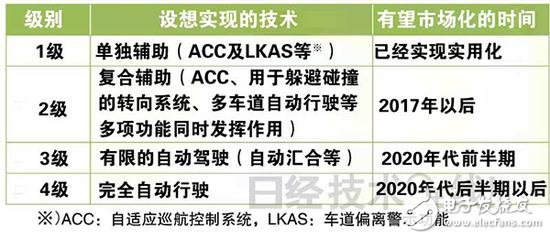
The research project has planned specific research projects and research contents, including four aspects: Development of automated driving systems; 2. To improve the infrastructure of traffic accidents and traffic jams; Advancement of international cooperation; The development of the next generation urban transportation system.
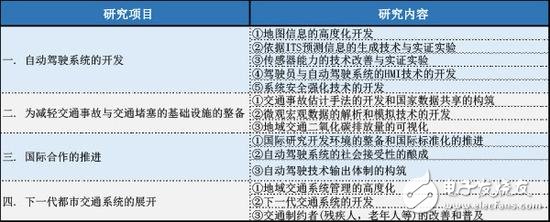
The Japanese Police Department announced on April 7, 2016
Draft guidelines for empirical experiments on road autopilot. The contents include the driver's duties, vehicle equipment, accident countermeasures, etc., and clarify the road test regulations for self-driving cars. After a month of collecting opinions from the public, formal guidelines are already being worked out.
However, the draft requires that the vehicle meets the requirements of “Safety Standards for Road Transportation Vehicles (No. 67 of the Japanese Transportation Province Order No. 1951)â€, “There are drivers on the driver's seatâ€, and “Compliance with the Japanese Road Traffic Lawâ€. Fully automatic driving without driver and remote monitoring.
In addition, the guidelines set requirements for follow-up personnel, road test conditions, “hands-on†conditions, and accident prevention and response.
Follow-up personnel: The guidelines require that there must be a driver on the driver's seat to control the vehicle in an emergency. At the same time, it is best to have an operator who monitors the automatic driving system. When driving a car autopilot, it is necessary to equip a vehicle that is driving together to ensure safety.
On-road test conditions: To comply with the vehicle conditions stipulated by the existing laws (vehicles with the steering wheel or throttle removed cannot be tested), the autopilot system must also be able to work properly and take safety measures to deal with cyber attacks. In Japan, special procedures are not required for the implementation of automated driving technology road demonstration experiments. Even if the vehicle does not meet the safety standards, road evidence can be carried out as long as it is approved by the Minister of Land, Infrastructure and Transport. However, Japan does not clearly define the autopilot empirical experiment, so the experimenter may be punished.
“Let's drive†conditions: The big principle is the ability to respond immediately in an emergency. In "a place with a good line of sight and a small amount of traffic", you can let go completely. On "roads with poor sight or heavy traffic," the driver's hand should always be placed near the steering wheel.
Accident prevention and response: After the accident occurs, stop the experiment temporarily before taking measures to prevent the accident from happening again. In order to facilitate verification after an accident, the test vehicle must be equipped with a driving recorder to keep relevant records of the vehicle information and surrounding conditions. And the vehicle requires insurance.
In addition to actively defining automatic driving grading and developing new guidelines, Japan is also simultaneously revising relevant regulations such as the Road Traffic Act and the Road Transport Vehicles Act to enable self-driving cars to land on 2020.
The Ministry of Economy, Trade and Industry, the Ministry of Land, Infrastructure, Transport and Tourism and the Japan Automobile Industry Association established the "Automated Driving Research Institute (tentative name)" in April 2016. Since Japan participated in the development of UN standards, the Autopilot Institute formed a unified mastery of UN and international standardization. Organizational (ISO) security technology and communication standards rules discussion system.
EuropeCooperative Intelligent Tran- Sport Systems (Cooperative ITS or C-ITS) was promoted by the European Union through the M/253 Authorization Act in 2009 and officially deployed in 2015. In the cooperative security application standard classification, the branches of active road security include cooperation awareness, collision avoidance, and early warning.
The EU will develop a road traffic safety strategic action plan every 10 years. In July 2010, the European Commission submitted to the European Parliament, the Council of the European Union, the EU Economic and Social Committee and the European Union Regional Committee the "EU's 2011-2020 Road Traffic Safety Policy Orientation (Draft)" (hereinafter referred to as "EU Planning"). The fourth road traffic safety strategic action plan has become the blueprint and common action strategy for the road safety of the EU in the next 10 years.
In the task of improving the application level of ITS in the field of new technology application work, it is proposed to evaluate the specific measures for applying the driver assistance system (lane deviation warning system, collision warning system, pedestrian recognition system).
(1) SwedenThe Swedish Parliament has initiated legal analysis of autonomous driving and is expected to revise Congressional review in 2017 to ensure that autonomous driving can be legally sold and used by 2020. The first draft of the Automated Driving Public Road Test Specification has been finalized in March 2016 and entered the government review and parliamentary review process, which is expected to take effect on May 1, 2017. The final version applies to all types of vehicles with automatic driving levels, including semi-automatic driving, highly automated driving and fully autonomous vehicles.
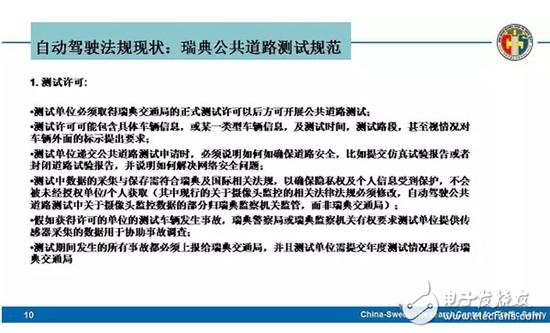
Sweden has relatively well-established regulations on automatic driving public road testing. First of all, to obtain a test permit, you need to go to the Swedish Transport Bureau to obtain a formal permit to conduct public road testing. The test unit must submit a public road application, suggest that possible safety hazards should be included, and ensure that test data collection and preservation are in line with international standards. Relevant regulations and personal privacy information are protected.
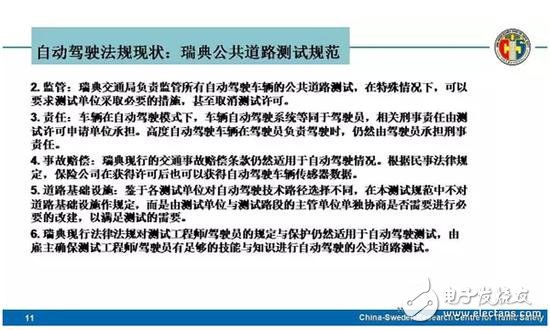
The Swedish Transport Agency is responsible for monitoring public road testing of all self-driving vehicles. The self-driving vehicle is responsible for the system, and the driver is responsible for the highly self-driving vehicle when the driver tests. Testing the Licensed Unit Vehicles In the event of an accident, the Swedish Police Department and the relevant units have the right to request the test unit to provide data collected by the sensor and assist in the accident investigation. The test unit shall hand over all accidents during the test to the Swedish Transport Bureau, and report the annual test report to the supervisory unit. Current regulations are for test engineers and drivers and still apply to autonomous driving.
(2) FranceIn August 2016, in the context of the “New Industry in France†initiative, the French government announced that it would allow foreign car companies to test autonomous vehicles on public roads. Prior to this, the French government only allowed local car companies to test the automatic driving system technology on the road.
(3) FinlandOn July 15, 2016, the Finnish Transportation Safety Administration approved the unmanned bus on the road in Finland. The law does not specifically require the motor vehicle to have a driver.
SingaporeIn 2013, the Land Transport Authority and the Singapore Science and Technology Research Bureau signed a five-year memorandum of cooperation to implement the Singapore Autonomous Vehicle Initiative (SAVI) to promote the research and application of driverless technology.
The program is responsible for the development, research and testing of automated vehicle technology, including the following three aspects: 1. Research on the use of unmanned vehicles, such as driverless buses, to provide the feasibility of public transport services operating at fixed times and on road sections; Sharing the regional transportation system of the automatic vehicle; Study the technical and legal requirements involved in the widespread use of unmanned vehicles in the future.
In 2014, Singapore established the Self-driving Vehicles Motion Committee to regulate the research and testing of self-driving cars. The local land transport authority has designated one-north as the first unmanned public road pilot, piloted by Singapore's land and transportation department, allowing people to test unmanned vehicles on their roads.
to sum upThe technology is maturing, and the overall trend of market education is optimistic. On this basis, the policy urges automakers to increase their own chips, thus igniting the development of the ADAS market. Considering that the pre-installation test runs in 2-3 years, Domestically, the ADAS entrepreneurial boom has been triggered in recent years.
LDS-level ADAS functions such as BDS and LDW have gradually become popular in the domestic market, and L1-level AEB and ACC functions have begun to sprout. With the help of regulations, the cost of mature technology's ADAS function will further decline, and it will sink to less than 100,000 models. AEB and ACC will become the next stage functions for the new car.
But at the same time, we can see that the entire industry is still at the stage of exploration. After the formal regulations are introduced and the current concept definitions, related technologies and safety standards, and test requirements are further unified, the development of ADAS to autonomous driving will be further accelerated.
Different from traditional FR-4 (plastic), ceramic materials have good high-frequency performance and electrical properties, and have properties that organic substrates do not have, such as high thermal conductivity, excellent chemical stability and thermal stability. Ideal packaging material for large scale integrated circuits and power electronic modules.
Ceramic PCB Manufacturer,Ceramic PCB Board,Ceramic Circuit Board,Ceramic Printed Circuit Board,How to Manufacture PCB
Huizhou Liandajin Electronic Co., Ltd , https://www.ldjpcb.com